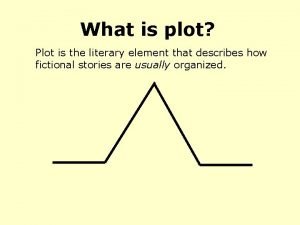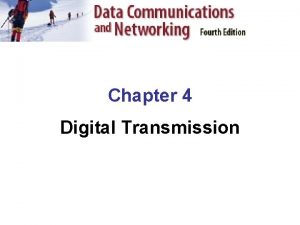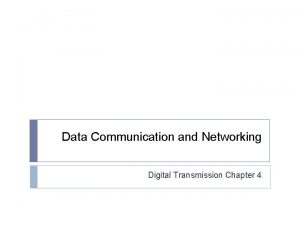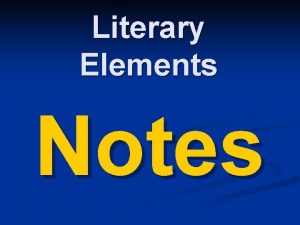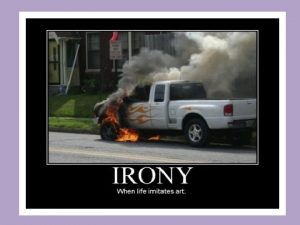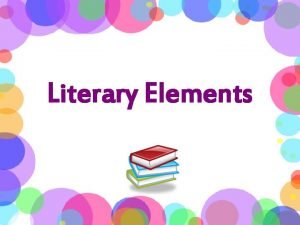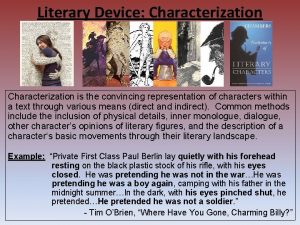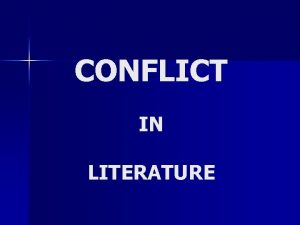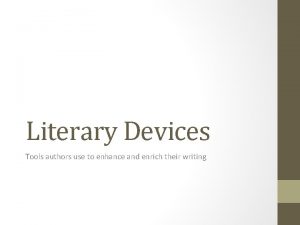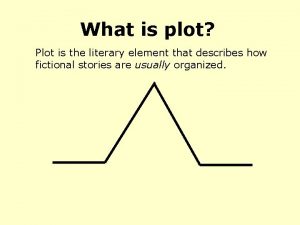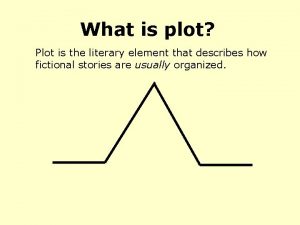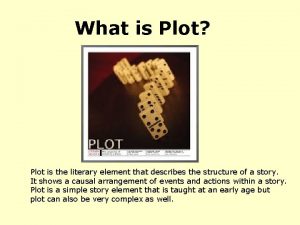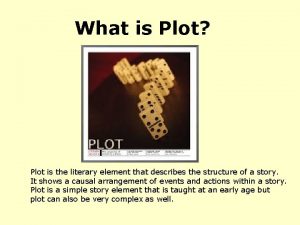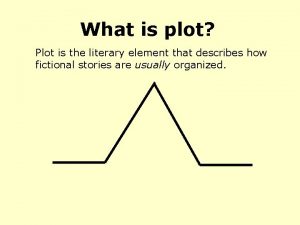What is Plot Plot is the literary element











- Slides: 11

What is Plot? Plot is the literary element that describes the structure of a story. It shows a causal arrangement of events and actions within a story. Plot is a simple story element that is taught at an early age but plot can also be very complex as well.

Plot versus action For the purposes of this class, the events that happen in a novel will be referred to the action of the novel. The term plot will be used for the way an author sequences and paces the events. This helps shape our response and interpretation of the literary work.

What are Plot Components? Climax: the turning point, the most intense moment—either mentally or in action Rising Action: the series of conflicts and crisis in the story that lead to the climax Exposition: the start of the story, the situation before the action starts Falling Action: all of the action which follows the climax Resolution: the conclusion, the tying together of all of the threads Conflict: Conflict is the dramatic struggle between two forces in a story. Without conflict, there is no plot.

What is Plot Structure? Freytag’s Pyramid is often modified so that it extends slightly before and after the primary rising and falling action. You might think of this part of the chart as similar to the warm-up and cooldown for the story.

Time Manipulators Flashbacks A literary or cinematic device in which an earlier event is inserted into the normal chronological order of a narrative. Purpose: It is a technique that bridges time, place and action to reveal information about the character, or move the story forward. Flash-forward A literary or cinematic device in which the chronological sequence of events is interrupted by the interjection of a future event. Purpose: To show the consequences of events and actions on characters within a story without having to follow the impact of those events in normal narrative setting. To give a reader a glimpse of a possible future for the characters within a story. It could occur anywhere within a story, most often used to show “happy endings. ” Foreshadowing The presentation in a work of literature of hints and clues that tip the reader off as to what is to come later in the work. Purpose: To allow readers to come to certain conclusions (make things more believable) about characters and events within a story. Furthermore, it builds anxiety, and suspense throughout a storyline

What is a SUBPLOT? A subplot is a secondary story line that is not equal in strength and intensity to the main plot. It must be relevant to the main plot. Subplots may: create the feeling of more life-like main characters. reflect and enhance the action of the main plot. influence the direction of the main plot. provide comic relief.

Examples of subplots: 1. In the main plot of a romance, one or both of the main characters may resist commitment. Another couple in the story, perhaps friends, confidantes, or coworkers of the main characters, are also falling in love but having problems that show aspects of the love relationship the primary story line does not. The main characters, through their involvement with the other couple, may learn from what they see and come to realize their own love for each other should not be denied. 2. In a story of conflict between a parent and a child, subplots involving a neighbor or friend's child may give some perspective on the main plot. Another subplot might be a visit from a grandparent that casts the parent back into the child role, an experience that helps that parent recall what his own childhood was like and results in a better understanding of his own child's behavior.

Dramatic or Progressive Plot A Dramatic or Progressive Plot: This is a chronological structure which first establishes the setting and conflict, then follows the rising action through to a climax (the peak of the action and turning point), and concludes with a denouement (a wrapping up of loose ends). The majority of stories and novels that you read will follow this plot structure.

Parallel Plots: Plots in which each main character has a separate but related story line that merges in the end. Examples: Murderer and Detective Two family members with opposite goals or methods Rivals for a job Old enemies In the plot outline, main character 1 has the first section. The story then moves to main character 2 and alternates between the two characters until they come together in the end. Each main character and his or her plot receive equal time. Their sections are indicated by the series of parallel lines on the timelines below. Each segment of the story moves the plot forward in time. An occasional scene may overlap in time, but the general movement should be forward. Plot Diagram for Parallel Plot Structure ||||------|||||-------------||||--------------- Plot line for main character 1 -----||||-------------||||--------------||||------Plot line for main character 2

In the parallel plot, the characters might start out together and separate to follow their own paths, or they may not connect until the end. Their story lines are related and the climax occurs when the two (or more) come together at the end. Parallel plots may have more than two main characters. Just remember that each character's story gets equal time and to keep the plot moving forward. Once each main character is introduced, the writer then returns to the first character and repeats the cycle. Examples: School reunions, earthquakes and other natural disasters, terrorist attacks Plot Diagram for Parallel Plot Structure ||||------|||||-------------||||--------------- Main character 1 -----||||-------------||||--------------||||------- Main character 2 -----|||||--------------||||-------------||||-- Main character 3

Parallel Plots 1. In the plot outline, main character 1 has the first section. The story then moves to main character 2 and alternates between the two characters until they come together in the end. Each main character and his or her plot receive equal time. Each segment of the story moves the plot forward in time. An occasional scene may overlap in time, but the general movement should be forward. 2. In the parallel plot, the characters might start out together and separate to follow their own paths. Or they may not connect until the end. Their story lines are related and the climax occurs when the two come together at the end.
 What is subplot in literature
What is subplot in literature What is plot
What is plot Is plot a literary element
Is plot a literary element What is plot
What is plot Signal element vs data element
Signal element vs data element Difference between signal element and data element
Difference between signal element and data element Literary element
Literary element Irony is a literary device
Irony is a literary device What is literary elements
What is literary elements What is characterization literary device
What is characterization literary device Literary element conflict
Literary element conflict Symbol in literary devices
Symbol in literary devices

